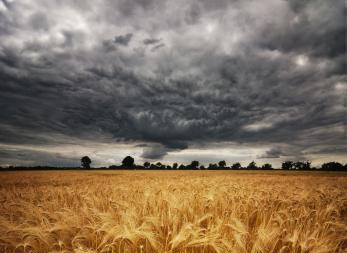While parts of New Zealand and Japan have been badly affected by flooding, developing countries - especially in south and south east Asia - have once again borne the brunt in terms of scale, impact, injury and loss of life. Among other countries, significant flooding has occurred over the period in India, Nepal, Pakistan, Vietnam, China, the US, Bosnia, Macedonia, Costa Rica, Colombia, Kenya, Zambia, Russia and Mexico.
Despite severe storms and tornadoes striking mid-western states in May, the US recorded its lowest tornado death toll since records began in 1875: just seven killer tornadoes resulting in 16 deaths. Preliminary figures suggest a total tornado number of 1086 for the 2004 season, compared to 1376 in 2003. While tropical storms and typhoons caused damage and loss of life in the Philippines, Myanmar, Micronesia, Taiwan and China, the Atlantic hurricane season has had a quiet start, despite predictions of above average activity by Tropical Storm Risk (TSR) in the UK, the US National Hurricane Center and Colorado State University's Tropical Meteorology Project.
On the tectonic front, another disastrous earthquake struck within two months of the Bam quake that took an estimated 26,000 lives in December 2003. This time northern Morocco took a hit, leading to severe damage and the loss of over 600 lives. Three further lethal earthquakes occurred in eastern Turkey - in March and July, in Afghanistan in April, and in Iran in May - each taking a small numbers of lives. Volcanic activity has not impinged upon people or property, although landslides have caused problems in the former Soviet state of Kyrgyzstan, taking more than 30 lives during April.
Territory: Haiti and the Dominican Republic
Region: Southern part of the island of Hispaniola including the Dominican Republic provinces of Independencia (including the town on Jimani), Elias Pina, Duarte, and Sanchez Ramirez. In Haiti, the south, west and south east departments, including the town of Mapou, were severely affected.
Date: 24 - 25 May 2004
Event: Flood
Impact: As of mid-July, the death toll is around 2,000 with hundreds more still missing and presumed dead. In the town of Jimani alone, 393 lives have been lost and 274 people are still missing. More than 25,000 people have been made homeless, with over 3,000 homes destroyed by floods and landslides and many more damaged. The impact of the flooding was greatly exacerbated by extensive deforestation in the region and by the growth of settlements in flood plains and at the base of steep slopes. Economic loss figures are not yet available but are expected to be significant, proportional to the GDPs of the two countries
Summary: A low pressure system originating in Central America and tracking across the central Caribbean brought torrential rains to the island of Hispaniola between 18 and 25 May. Moist, low level southerly winds interacted with the topography to intensify the rainfall in the mountainous Massif de la Salle region that straddles both countries in the south of the island.
Here, rainfall over the period exceeded 500 mm, with 250 mm falling in just 24 hours at the town of Jimani in the Dominican Republic. The rains triggered the formation of flash floods, landslides and mudflows, and caused a number of river systems to overflow on the north and south flanks of the massif. The worst flooding occurred on 24 and 25 May when the Solie River burst its banks.
Data sources: NASA Earth Observatory
earthobservatory.nasa.gov/Study/Haiti2004/ReliefWeb www.reliefweb.int Additional sources: Dartmouth Flood Obervatory
Territory: Morocco
Region: Al Hoceima province (NE Morocco), 300 km ENE of the capital Rabat
Date: 24 February 2004
Event: Earthquake
Impact: The earthquake occurred in the Gibralter Strait, close to Al Hoceima, a coastal city with around 100,000 inhabitants. Most seriously affected were the surrounding villages including Ait, Kamara, Tamassint and Imzouren, where the main building material is adobe (mud brick). The final death toll is estimated at 629 with close to a thousand more injured.
Over 15,000 people were made homeless. According to local news reports around 40 residential buildings were destroyed, with many others sustaining minor to severe structural damage. Lifelines were relatively unscathed, with power out for a time but with roads and the water system largely unaffected. No information on economic losses is currently available.
Summary: A strong earthquake, registering a magnitude of 6.4, struck northern Morocco during the early hours of 24 February. The shallow (13 km) quake occurred close to the eastern end of the Rif mountain belt, which marks the diffuse boundary in this area between the African tectonic plate to the south and the Eurasian plate to the north. The earthquake occurred in the Al Hoceima region of the country, close to the site of a magnitude 6.0 event that occurred in 1996. Ground shaking associated with the earthquake was felt as far east as the Spanish enclave of Melilla 250 km away, and along the southern coast of Spain 150 km distant. Aftershocks as large as magnitude 5.5 continued for up to a month after the main event.
Peak horizontal accelerations of 0.25 g were recorded 21 km from the epicentre at the El Khattabi Dam, which sustained minor damage.
Data sources: USGS Earthquake Hazards
Program: earthquake.usgs.gov
ReliefWeb www.reliefweb.int Additional sources: Earthquake Engineering Research Institute
www.eeri.org Territory: New Zealand
Region: Lower North Island (Manuatu - Wanganui, Taranaki and Wellington) and some parts of the upper South Island (Marlborough)
Date: 15 - 21 February 2004
Event: Flood
Impact: Gale force winds left 15,000 people without power, while rising floodwaters led to the evacuation of more than 1,000 people. In some parts of the affected areas up to 70 % of roads were underwater, with the capital - Wellington - cut off for a time. Key roads, including State Highways 4, 54 and 56 were partially closed, along with many local and provincial roads. At least 19 bridges were destroyed or badly damaged, along with a major gas pipeline. Over 1,500 phone lines were out of commission and water supplies and sewerage systems were seriously affected. A state of emergency was declared over much of the lower North Island, affecting around 200,000 people. Two deaths were reported. Agriculture and forestry was also badly hit, with serious arable and livestock losses. Estimates of the cost of the agricultural losses range between NZ$159 and NZ$180 million. Insured losses totalled NZ$112 million.
Summary: The worst summer storm for 40 years struck the lower North Island on 15 and 16 February, causing structural damage and triggering landslides, erosion and widespread and locally severe flooding. Wind speeds as high as 150 kmh were recorded around the capital Wellington, where rainfall was already four times greater than average for February. Torrential rains continued into 21 February resulting in the levels of major rivers reaching a 100 year high. Levels of the Manawatu river were the second highest ever recorded (after 1902), while peak discharge on the Rangitikei river was the third highest since 1897.
Data sources: ReliefWeb
www.reliefweb.int Insurance Council of New Zealand
Additional sources:
NASA Earth Observatory
earthobservatory.nasa.gov
Territory: North Korea
Region: Ryongchon City, North Pyongang province
Date: 22 April 2004
Event: Freight train explosion
Impact: The blast excavated a crater 15m deep and devastated an area up to 2 km across. Around 8,100 homes and 129 government buildings are estimated to have been destroyed or damaged - around 40% of the city.
The human toll is 161 dead - including 75 school children - and a further 1,300 wounded. Government estimates of resulting economic losses are $93 million.
Summary: The explosion appears to have been caused (according to the Korea Central News Agency) by an electrical short circuit that happened during the track switching, at Ryongchon station, of fuel-laden tanker wagons and others containing ammonium nitrate fertiliser.
Data sources: ReliefWeb www.who.int/disasters Territory: United States
Region: Denver, Colorado
Date: 8 - 9 June, 2004
Event: Hailstorm
Impact: Homes and automobiles bore the brunt of the storm's effects.
Thousands of vehicles parked unprotected on the forecourts of car show rooms were damaged, and the number of auto-related insurance claims is expected to top 27,000. Homes suffered hail damage, in particular to roofs and cladding, together with flooding associated with the torrential rainfall and melting hail accumulations, leading to an expected 20,000 insurance claims. Economic losses have yet to be determined, but the total insurance loss is expected to be around $146.5 million. This makes the event the fourth largest natural catastrophe insurance loss in Colorado's history.
On average, the state with experience between three and five damaging hailstorms during the months of June and July, together with between 35 and 40 tornadoes every year.
Summary: Two severe, back-to-back summer storms dumped golf ball and baseball sized hail on the cities of Golden and Lakewood and on metropolitan Denver. Hail stones up to 4 cm across were reported, accumulating in places to form drifts more than 30 cm deep. The hail was accompanied by tornadoes, one of which caused damage in the town of Sterling. The hail was accompanied by strong winds of up to 100 km h, together with torrential rain that led to extensive flash flooding. Precipitation rates as high as 7 cm a second were recorded. The summer storms are the most damaging to strike the Denver area for more than a decade.
Data sources: Rocky Mountain Insurance Information Association
www.rmiia.org Insurance Journal
Territory: Japan
Region: Niigata, Fukui and Fukushima prefectures, NW Japan
Date: 13 - 18 July
Event: Floods and mudslides
Impact: 24,000 homes in the prefecture were damaged by floods or landslides.
More than 136,000 residents were ordered or advised to evacuate. The death toll, as of 18 July, was 18, with a further five people missing. Worst hit were the city of Sanjo and the adjacent town of Nakanoshima, where rising river levels caused protective embankments to collapse, leading to the flooding of around 60% of Nakanoshima and the inundation of 5,000 buildings in Sanjo. The rivers most severely affected included the Asuwa, Kiriyata and Ikarashi. Niigata is one of Japan's major rice growing regions, and reports suggest that wide swathes of rice fields have been buried in mud. No loss figures are yet available.
Summary: Torrential rains starting on 13 July, and associated with a frontal system, dumped a record 400 mm of rain in the Niigata region by 15 July, with further intense rainfall following. Rain fell at more than 43 mm an hour in many places. Three rivers burst their banks in the prefecture, while surface run-off also triggered close to 400 landslides.
Data sources: Pacific Disaster Management Information Network
pdmin.coe-dmha.org
Dartmouth Flood Observatory
www.dartmouth.edu Additional sources: ReliefWeb www.reliefweb.int Territory: India, Bangladesh, Nepal, Bhutan
Region: Bihar, Assam and West Bengal (India), Dhaka, Narayanganj, Bogra, Sylhet (Bangladesh), eastern and central Nepal
Date: Mid - June - July, 2004
Event: Flood
Impact: In the Indian state of Bihar, 20.2 million people were affected, with 380,000 evacuated and 350,000 homes destroyed or badly damaged. In neighbouring Assam, the number affected is put at 10.1 million, with 112 dead. In Bangladesh, more than 19 million people are affected, with 185 dead. Here, over 11,000 square kilometres of land has been inundated, with 151,000 homes destroyed and another 1.2 million damaged. 23,000 km of roads and 1,700 bridges or culverts have been destroyed or damaged, along with one and a half million acres of crops. Half a million people remain in shelters in Bangladesh. The current overall death toll is above 800 and rising. The full economic cost of the disaster remains to be established.
Summary: Severe monsoon conditions led to some of the worst flooding in living memory across NE India, Bangladesh, Nepal and Bhutan. Although arriving late, the monsoon is not unusually intense, and anthropogenic factors such as deforestation and urbanisation are being blamed for the scale of the flooding. Most of the rivers in the great drainage basins of the Brahmaputra - Jamuna, Ganges - Padma and Megna have reached unprecedented or danger levels. The floods are expected to persist at least until early August, when high tides in the Bay of Bengal, related to a full moon on 1-2 August, will hinder the outflow of floodwaters.
Data sources: Pacific Disaster Management Information Network
pdmin.coe-dmha.org
ReliefWeb www.reliefweb.int Additional sources: NASA Earth
Observatory: earthobservatory.nasa.gov.


















